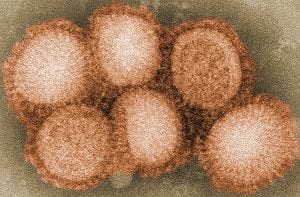
Simon Fraser University virologist Masahiro Niikura and his doctoral student Nicole Bance are among an international group of scientists that has discovered a new class of molecular compounds capable of killing the influenza virus.
Working on the premise that too much of a good thing can be a killer, the scientists have advanced previous researchers’ methods of manipulating an enzyme that is key to how influenza replicates and spreads.
Their new compounds will lead to a new generation of anti-influenza drugs that the virus’ strains can’t adapt to, and resist, as easily as they do Tamiful. It’s an anti-influenza drug that is becoming less effective against the constantly mutating flu virus.
These increasingly less adequate anti-influenza drugs are currently doctors’ best weapons against influenza. They helped the world beat H1N1, swine flu, into submission four years ago.
The journal Science Express has just published online the scientists’ study, revealing how to use their newly discovered compounds to interrupt the enzyme neuraminidase’s facilitation of influenza’s spread.
Tamiful and another anti-influenza drug, Relenza, focus on interrupting neuraminidase’s ability to help influenza detach from an infected cell’s surface by digesting sialic acid, a sugar on the surface of the cell. The flu virus uses the same sugar to stick to the cell while invading it. Once attached, influenza can invade the cell and replicate.
This is where the newly discovered compounds come to the still-healthy cells’ rescue. They clog up neuraminidase, stopping the enzyme from dissolving the sialic acid, which prevents the virus from escaping the infected cell and spreading.
The new compounds are also more effective because they’re water-soluble. “They reach the patient’s throat where the flu virus is replicating after being taken orally,” says Niikura, a Faculty of Health Sciences associate professor.
“Influenza develops resistance to Replenza less frequently, but it’s not the drug of choice like Tamiful because it’s not water-soluble and has to be taken as a nasal spray.
“Our new compounds are structurally more similar to sialic acid than Tamiful. We expect this closer match will make it much more difficult for influenza to adapt to new drugs.”
The Latest on: Killing the influenza virus
[google_news title=”” keyword=”killing the influenza virus” num_posts=”10″ blurb_length=”0″ show_thumb=”left”]
via Google News
The Latest on: Killing the influenza virus
- Bird flu found in northeastern Colorado dairy herdon April 27, 2024 at 2:31 pm
A U.S. Department of Agriculture laboratory confirmed Thursday the detection of Highly Pathogenic Avian Influenza H5N1 from dairy cows in a northeastern Colorado herd. It is the first detection of the ...
- Bird Flu H5N1—What We Know So Far About Its Spread To Cowson April 27, 2024 at 9:50 am
Information about the bird flu outbreak is rapidly changing. This post summarizes our current knowledge and gaps.
- Bird flu is spreading. Are supermarket eggs and milk safe?on April 27, 2024 at 8:59 am
The CDC maintains that bird flu viruses do not normally infect humans, however, in a current situation summary, the organization says that, “sporadic human infections with bird flu viruses have ...
- Avian flu has spread to cows, milk — and experts worry human outbreak could be nexton April 26, 2024 at 9:09 pm
This time, it's in Gratiot County. An MDARD spokesperson told the Free Press that a state law, Public Act 466, prohibits the agency from releasing any details that would identify the commercial ...
- Amid bird flu spread, experts reveal if it's safe to drink milk: 'Indirect concern'on April 26, 2024 at 5:16 pm
Traces of bird flu have been detected in pasteurized milk, leaving many people wondering if it’s safe to drink. Doctors offered their insights about the potential risk.
- Federal Officials Find No Live Bird Flu Virus in Initial Milk Testson April 26, 2024 at 4:11 pm
The early results suggest that pasteurization is killing the H5N1 virus in milk, something that regulators were not certain of.
- Pasteurization working to kill bird flu in milk, early FDA results findon April 26, 2024 at 3:52 pm
Around 1 in 5 retail milk samples had tested positive for the bird flu virus, but further tests show it was not infectious.
- Is Dairy Safe Now That Traces of Bird Flu Are in Milk?on April 26, 2024 at 1:13 pm
A strain of highly pathogenic avian influenza that’s been decimating wild and captive flocks of birds since 2020 has spread among US dairy cows — and has infected one person in Texas exposed to the ...
- Bird Flu (H5N1) Explained: Here’s What To Know—And Why Scientists Are Concernedon April 26, 2024 at 12:41 pm
Bird flu typically spreads among birds, but there have been recent outbreaks among cattle in the U.S., and one Texas man contracted the virus from sick cows. Here’s why so many experts are worried ...
- Early test results show pasteurized milk with traces of H5N1 virus isn’t infectious, FDA sayson April 26, 2024 at 11:32 am
The US Food and Drug Administration said Tuesday that it had detected viral particles of H5N1 avian influenza in milk purchased at grocery stores, but the agency says it still believes that the milk ...
via Bing News










